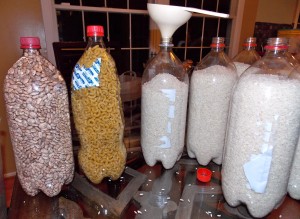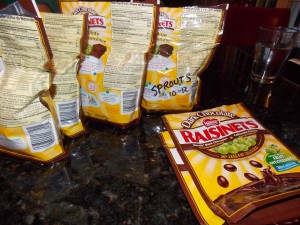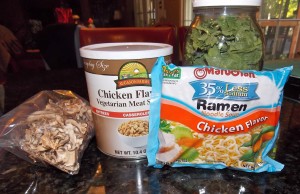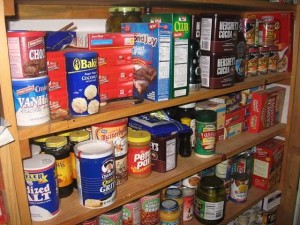For our family, as I discussed in last month’s post, there are a number of obstacles to long term food storage. It is not only about packaged vs. fresh foods, but some of the traditional prepper foods and storage methods are EXPENSIVE! Food that comes in #10 cans can be very pricey, and putting away my own foods in mylar and buckets was just not working for me (though I did it heavily in those first few months). Last is a common prepper notion that anyone will eat anything if they are hungry enough (and by this people usually mean beans and rice). That is just not a realistic approach with kids, especially if you are trying to get them to support your prepper habits. At our house we have embarked on ways to incorporate long term food storage into everyday life so that if the SHTF, the food will not be foreign and mysterious (aka “ICKY”).
 The ideal of prepper packaging for the apocalypse seems to be centered around big mylar bags and 5-gallon buckets. I personally hate both of these things. I hate the big bag because it costs money, it makes it almost impossible to check on your food or to use it in any sort of rotation. And I really hate the buckets because they are round which wastes space on shelves. They also weigh a ton and make it impossible for me to move without assistance, which I may not have in an emergency. I do occasionally use the thick gallon sized mylar bags for food storage, but more
The ideal of prepper packaging for the apocalypse seems to be centered around big mylar bags and 5-gallon buckets. I personally hate both of these things. I hate the big bag because it costs money, it makes it almost impossible to check on your food or to use it in any sort of rotation. And I really hate the buckets because they are round which wastes space on shelves. They also weigh a ton and make it impossible for me to move without assistance, which I may not have in an emergency. I do occasionally use the thick gallon sized mylar bags for food storage, but more  frequently I recycle other containers. Currently I am storing beans, rice, flour, oatmeal and macaroni noodles in 2-liter soda bottles with two 100cc oxygen absorbers. On the internet you will see some debate as to the long term viability of these bottles, but I think as long as you are using the thicker PET bottles, there is no reason not to use them. Please note that water bottles are much thinner than soda bottles and I only use those for water. I feel the pros outweigh any cons. So far they have a beautiful air tight seal (as evidenced by their deflation caused by the 02 absorbers), I have the ability to visually check my product, they are much easier to move around by myself, and I can use my long term food storage as needed in smaller quantities without opening an entire 5-gallon bucket of something. The other container that I have taken to re-using is small mylar bags from some of our regular food items. For instance a bunch of candies and even prunes come in small mylar bags with ziplock seals on the top (at our house it’s Raisinettes). I clean these bags out and use them for storing popcorn (my husband’s favorite treat) and bean sprout seeds. These smaller bags are the perfect size for both. I treat them just like any purchased mylar bag: insert my food, drop in a 100cc O2 absorber and heat seal it as usual (but just below the ziplock seal area).
frequently I recycle other containers. Currently I am storing beans, rice, flour, oatmeal and macaroni noodles in 2-liter soda bottles with two 100cc oxygen absorbers. On the internet you will see some debate as to the long term viability of these bottles, but I think as long as you are using the thicker PET bottles, there is no reason not to use them. Please note that water bottles are much thinner than soda bottles and I only use those for water. I feel the pros outweigh any cons. So far they have a beautiful air tight seal (as evidenced by their deflation caused by the 02 absorbers), I have the ability to visually check my product, they are much easier to move around by myself, and I can use my long term food storage as needed in smaller quantities without opening an entire 5-gallon bucket of something. The other container that I have taken to re-using is small mylar bags from some of our regular food items. For instance a bunch of candies and even prunes come in small mylar bags with ziplock seals on the top (at our house it’s Raisinettes). I clean these bags out and use them for storing popcorn (my husband’s favorite treat) and bean sprout seeds. These smaller bags are the perfect size for both. I treat them just like any purchased mylar bag: insert my food, drop in a 100cc O2 absorber and heat seal it as usual (but just below the ziplock seal area).
I find those #10 cans to be a bit of a mystery. Typically, the types of foods that I buy in #10 cans or in buckets are things that I cannot store myself, primarily protein items and vegetables that are tough to store/delicate to handle, or luxury items like butter and sour cream which would dress up storage foods for recipes. TVP, powdered eggs & cheeses, spinach and broccoli are items that we have recently been purchasing in cans. We had absolutely no experience with them and were not sure if we even wanted to buy them in cans or buckets without trying them first (Costco and Sams sells in bucket sizes). Fortunately, on their websites Auguson Farms and Shelf Reliance sell most of their products in small soup sized cans/mylar containers that are perfect for sampling. We ordered an assortment and are working our way through them to see which we want to buy in bulk. I will mention that on the Costco website, one of the food manufacturers (Thrive) sells their items sealed in a mylar pouch, in a bucket with a gamma seal (reusable lid), while many other companies only put the item directly into a traditional bucket with a one time use lid. In any event, like everything else, these dehydrated foods take practice to be able to use them effectively. And by trying the sample sizes, we feel we are making more specific choices about which ones we would truly use in an emergency.
 So what do I store that makes all this food storage work for our family? How do I tie it all together to get the kids to eat it and still make it nutritional? For us it is all about the components. As long as the food contains a main item that my kids recognize, they can usually be coaxed into eating it. For us that is usually vegetables. My kids will never willingly drink powdered milk, so I make sure I have a bunch of their favorite cereals stored in mylar for long term (stashed away where they don’t see it in the pantry). Ramen anyone? It’s filled with empty pasta calories and high sodium, right? But after living in Japan, ramen is a staple in our household, much like rice, pasta and potatoes. I buy the low sodium ramen and then I start adding the nutrition in, normally fresh stuff. But with a little retraining, we are using chicken TVP, dried mushrooms, green onions and spinach (all that I dehydrated myself and vacuum sealed in mason jars), and fresh bean sprouts (that we grew ourselves in only a few days inside the house). Dried spinach seems to have a much stronger flavor than fresh (so don’t use as much). Another item that I store is curry powder, which can be added to any bean or rice dish for flavor (for us this is a familiar flavor after living overseas for so long). I have also started routinely using dehydrated vegetables in our regular recipes and have discovered that the kids often don’t recognize the difference. We also have a favorite “no-bake” cookie recipe which uses oatmeal, chocolate, sugar, and peanut butter and is made on the stove top (perfect without electricity!). It has been hard, but I am really trying to find ways to store foods that are familiar. Also, your food preps aren’t any good if you don’t have a list of recipes to go with it. As for my husband the bean hater…he will willingly eat almost anything if I can promise him that bowl of popcorn at the end of the day!
So what do I store that makes all this food storage work for our family? How do I tie it all together to get the kids to eat it and still make it nutritional? For us it is all about the components. As long as the food contains a main item that my kids recognize, they can usually be coaxed into eating it. For us that is usually vegetables. My kids will never willingly drink powdered milk, so I make sure I have a bunch of their favorite cereals stored in mylar for long term (stashed away where they don’t see it in the pantry). Ramen anyone? It’s filled with empty pasta calories and high sodium, right? But after living in Japan, ramen is a staple in our household, much like rice, pasta and potatoes. I buy the low sodium ramen and then I start adding the nutrition in, normally fresh stuff. But with a little retraining, we are using chicken TVP, dried mushrooms, green onions and spinach (all that I dehydrated myself and vacuum sealed in mason jars), and fresh bean sprouts (that we grew ourselves in only a few days inside the house). Dried spinach seems to have a much stronger flavor than fresh (so don’t use as much). Another item that I store is curry powder, which can be added to any bean or rice dish for flavor (for us this is a familiar flavor after living overseas for so long). I have also started routinely using dehydrated vegetables in our regular recipes and have discovered that the kids often don’t recognize the difference. We also have a favorite “no-bake” cookie recipe which uses oatmeal, chocolate, sugar, and peanut butter and is made on the stove top (perfect without electricity!). It has been hard, but I am really trying to find ways to store foods that are familiar. Also, your food preps aren’t any good if you don’t have a list of recipes to go with it. As for my husband the bean hater…he will willingly eat almost anything if I can promise him that bowl of popcorn at the end of the day!
So what secret food storage tips do you use? Any special ingredients in your closet that we might like to hear about?
 For some Americans, the S**T hit their fan last week — in the form of a partial federal government shut down. As a military family, that means we are watching the news closely. During times like these military members are required to continue serving, but will be “paid later” in full, once budget issues are resolved. Fortunately, in this instance, Congress voted to continue paying the military during the shutdown, but that is not always the case. Many other federal workers are furloughed, and may not ever be paid back. And it’s all perfectly legal.
For some Americans, the S**T hit their fan last week — in the form of a partial federal government shut down. As a military family, that means we are watching the news closely. During times like these military members are required to continue serving, but will be “paid later” in full, once budget issues are resolved. Fortunately, in this instance, Congress voted to continue paying the military during the shutdown, but that is not always the case. Many other federal workers are furloughed, and may not ever be paid back. And it’s all perfectly legal.  In the 90’s when the government was previously shut down, Congress voted to pay those employees back. But due to the current financial state, they are warning people that they can’t count on that this time. The icing on this particular poop-cake is that the 27th Amendment to the Constitution ensures that our Congressmen all continue to receive their pay, while the voters pay the consequences. In the military, when a leader fails to successfully lead they can be removed from their position under grounds of “loss of special trust and confidence” in their leadership. Think we can use that on our current politicians, straight across the board?
In the 90’s when the government was previously shut down, Congress voted to pay those employees back. But due to the current financial state, they are warning people that they can’t count on that this time. The icing on this particular poop-cake is that the 27th Amendment to the Constitution ensures that our Congressmen all continue to receive their pay, while the voters pay the consequences. In the military, when a leader fails to successfully lead they can be removed from their position under grounds of “loss of special trust and confidence” in their leadership. Think we can use that on our current politicians, straight across the board? This happens to be one of those times when preppers look like normal, forward thinking people who planned ahead for the day when the government fell into dysfunction. Yes, our family (and the military in general) is currently getting paid, but we’re still federal employees and don’t know what will happen. Many other federal employees are not currently working, or getting paid. So what is a prepper to do!??? It’s time to hit the food storage! At our house, we are still in limbo waiting to find out if we will be moving to a new duty station next summer (some of you may remember that my husband requested I STOP buying more food, so we can prepare for our next move without the surplus weight). Fall is also the time of year when I can fresh veggies, take stock of our long-term food storage, and rotate the goods. This will be the perfect opportunity to work towards cutting down on our food storage, rotating what we have, and saving money. We are looking forward to some interesting meals in the near future!
This happens to be one of those times when preppers look like normal, forward thinking people who planned ahead for the day when the government fell into dysfunction. Yes, our family (and the military in general) is currently getting paid, but we’re still federal employees and don’t know what will happen. Many other federal employees are not currently working, or getting paid. So what is a prepper to do!??? It’s time to hit the food storage! At our house, we are still in limbo waiting to find out if we will be moving to a new duty station next summer (some of you may remember that my husband requested I STOP buying more food, so we can prepare for our next move without the surplus weight). Fall is also the time of year when I can fresh veggies, take stock of our long-term food storage, and rotate the goods. This will be the perfect opportunity to work towards cutting down on our food storage, rotating what we have, and saving money. We are looking forward to some interesting meals in the near future!


